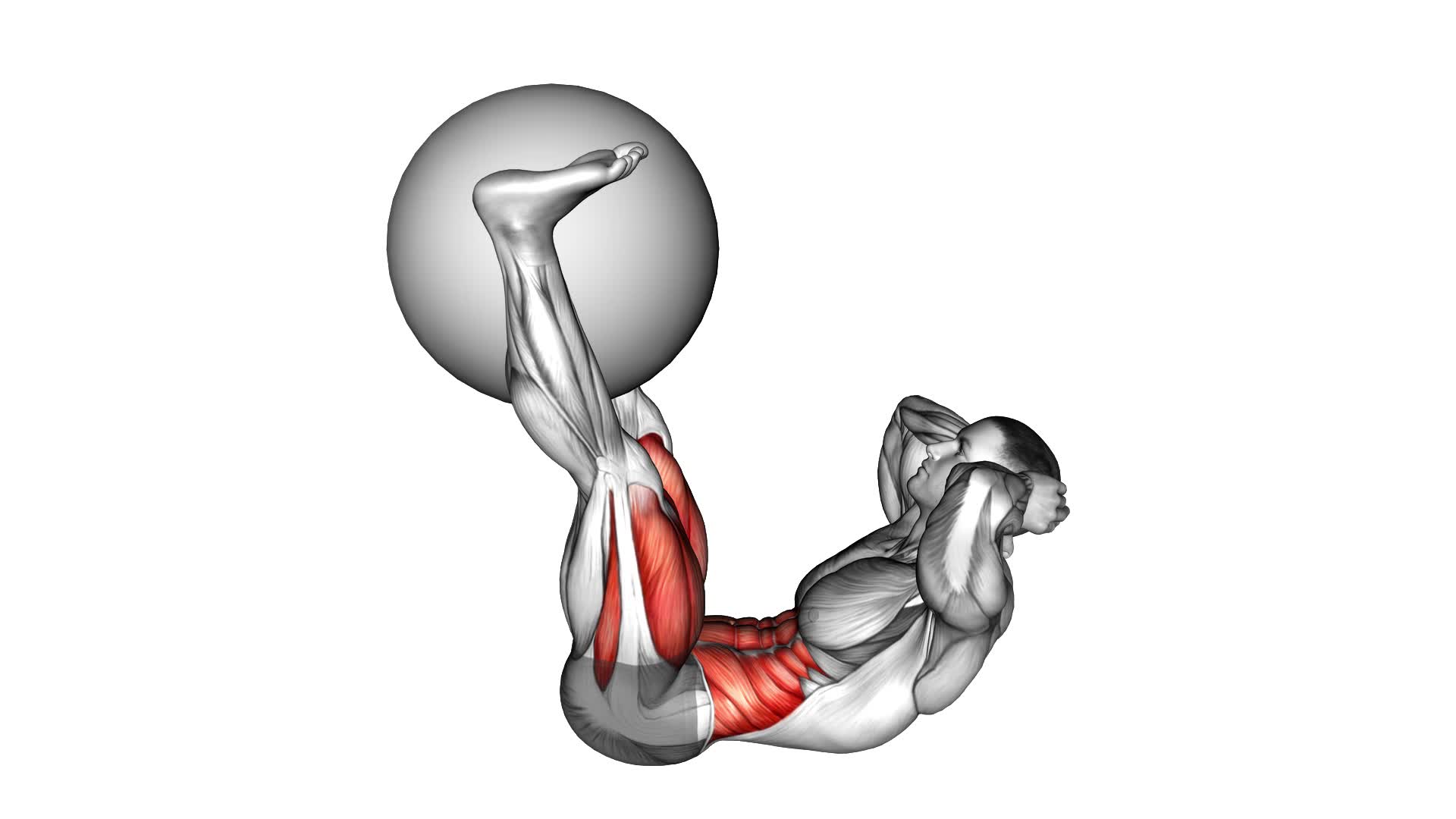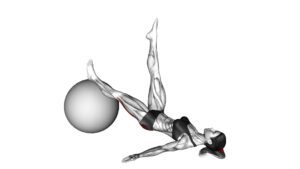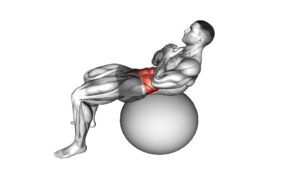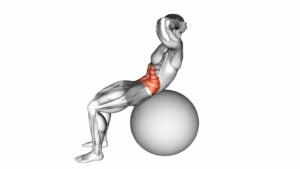Leg Extension Crunch (with Stability Ball) (male) – Video Exercise Guide & Tips

Get ready to sculpt your abs and strengthen your legs with the Leg Extension Crunch. This video exercise guide is specifically designed for men and features a stability ball for added challenge.
Watch This Exercise Video
Learn the proper form and technique, as well as modifications for beginners and advanced variations to push your limits.
Maximize your results with these tips and get ready to feel the burn in your core and lower body.
Let's dive in and crush those fitness goals!
Key Takeaways
- Targets muscles in abdomen, lower back, and hips
- Improves core strength and stability
- Enhances overall stability and balance
- Increases flexibility in lower back and hips
Benefits of the Leg Extension Crunch
The Leg Extension Crunch provides numerous benefits for improving core strength and stability. This exercise specifically targets the muscles in your abdomen, lower back, and hips, helping to strengthen and tone these areas. By engaging your core muscles, you can improve your overall stability and balance, making everyday movements easier and reducing the risk of injury.
In addition to improved core strength, the Leg Extension Crunch also helps to increase flexibility. As you extend your legs and lift your hips off the ground, you're stretching the muscles in your lower back and hips. This increased range of motion can enhance your athletic performance and make activities like bending, reaching, and twisting more comfortable.
To maximize the benefits of the Leg Extension Crunch, it's important to maintain proper form throughout the exercise. Start by lying flat on your back with your feet resting on a stability ball. Engage your core and lift your legs, extending them straight out in front of you. Then, contract your abs and curl your torso towards your knees, lifting your hips off the ground. Slowly lower back down and repeat for several reps.
Incorporating the Leg Extension Crunch into your fitness routine can lead to improved core strength and increased flexibility. As always, consult with a fitness professional before starting any new exercise program.
Equipment Needed for the Exercise
To perform the Leg Extension Crunch, you'll need a stability ball. This exercise requires minimal equipment, making it accessible to many individuals. Here are the items you'll need:
- Stability Ball: The stability ball provides support and stability during the Leg Extension Crunch. Choose a ball that's the appropriate size for your height and weight.
- Mat: While not essential, using a mat can provide added comfort and cushioning for your back and spine.
- Dumbbells (optional): For added resistance, you can hold dumbbells in your hands while performing the exercise. This can increase the intensity and challenge your muscles further.
These are the basic items you'll need to perform the Leg Extension Crunch. However, it's important to note that there are exercise modifications and variations that can be done to suit individual needs and preferences.
Now that you know the equipment required, let's move on to discussing the proper form and technique for the Leg Extension Crunch.
Proper Form and Technique
To perform the Leg Extension Crunch with proper form and technique, follow these steps.
- Start by lying on your back on a mat with your legs extended and your feet resting on a stability ball.
- Place your hands behind your head, elbows out to the sides.
- Engage your core muscles by drawing your belly button in towards your spine.
- As you exhale, lift your head, neck, and shoulders off the mat, curling your upper body towards your knees.
- At the same time, bend your knees and roll the stability ball towards your chest, keeping your feet on the ball.
- Hold the crunch position for a second.
- Inhale as you slowly extend your legs and roll the ball away from your chest, lowering your upper body back down to the mat.
- Repeat the exercise for the desired number of repetitions.
Remember to maintain control throughout the movement and avoid jerking or using momentum. Common mistakes to avoid include pulling on your neck with your hands, rounding your lower back, and using your hip flexors instead of your abdominal muscles.
Modifications for Beginners or Those With Injuries
If you're a beginner or have injuries, there are modifications you can make to the leg extension crunch with stability ball exercise. These modifications are injury-friendly and can help you ease into the exercise.
Additionally, there are beginner-friendly variations of the exercise that can help you build strength and confidence before progressing to the full movement.
Injury-Friendly Modifications
For beginners or those with injuries, modify the Leg Extension Crunch exercise by incorporating injury-friendly modifications. These modifications focus on injury prevention and rehabilitation techniques. Here are three injury-friendly modifications to consider:
- Use a lighter weight or resistance band: Reduce the load on your legs by using a lighter weight or a resistance band instead of a stability ball. This modification allows you to focus on proper form and technique without putting excessive strain on your muscles and joints.
- Perform the exercise on a mat: If you have knee or lower back issues, perform the Leg Extension Crunch on a comfortable mat. The mat provides extra cushioning and support, reducing the impact on your joints.
- Shorten the range of motion: Limit the range of motion by not fully extending your legs during the crunch. This modification decreases the stress on your knees and helps protect them from injury.
By incorporating these injury-friendly modifications, you can safely perform the Leg Extension Crunch while minimizing the risk of further injury or strain.
Remember to consult with a healthcare professional or certified trainer before attempting any new exercises, especially if you have existing injuries.
Beginner-Friendly Exercise Variations
When incorporating injury-friendly modifications, beginners or individuals with injuries can safely perform beginner-friendly variations of the Leg Extension Crunch exercise. These modifications are designed to provide a less intense workout while still targeting the core muscles effectively.
For beginners, it's recommended to start with a smaller range of motion and gradually increase it as strength and flexibility improve. This can be achieved by bending the knees at a smaller angle and not fully extending them during the exercise.
For individuals with injuries, it's important to consult with a healthcare professional or a qualified fitness trainer to determine the appropriate modifications based on the specific injury. They may recommend using a stability ball or adding additional support to reduce strain on the injured area.
Advanced Variations to Challenge Yourself
To challenge yourself further, there are several advanced variations you can try.
One option is to increase the resistance by adding weights or resistance bands to your leg extension crunch.
Another option is to incorporate unstable surface training by performing the exercise on a wobble board or Bosu ball.
Lastly, you can challenge your balance and coordination by adding in movements such as twisting or reaching while performing the leg extension crunch.
Increased Resistance Options
Challenge yourself with advanced variations to increase resistance in the Leg Extension Crunch exercise with a stability ball. Here are three resistance options that will take your workout to the next level:
- Add ankle weights: Strapping on ankle weights will provide additional resistance to your leg extensions, making the exercise more challenging and effective.
- Increase stability ball size: Using a larger stability ball will require more effort to stabilize your body, intensifying the resistance and engaging your core muscles even more.
- Incorporate resistance bands: Attach resistance bands to the stability ball and your ankles to add resistance throughout the entire range of motion, providing a continuous challenge to your leg muscles.
By incorporating these advanced resistance options into your leg extension crunch routine, you can progress in your fitness journey and achieve even greater results.
Push yourself to new limits and watch your strength and endurance soar.
Unstable Surface Training
To further challenge yourself and enhance the effectiveness of the Leg Extension Crunch exercise with a stability ball, incorporate advanced variations that involve training on an unstable surface.
Stability ball exercises are great for core strengthening, and adding an unstable surface will take it to the next level. One option is to perform the Leg Extension Crunch on a BOSU ball, which is a half-dome-shaped device that creates an unstable surface. This forces your core muscles to work harder to maintain stability during the exercise.
Another option is to use a balance board or a wobble cushion. These tools provide an even greater challenge as they require constant adjustments to maintain balance and stability.
Incorporating Balance and Coordination
Improve your balance and coordination by incorporating advanced variations that challenge your stability and core strength. Adding stability ball exercises to your workout routine can be a great way to take your balance and coordination training to the next level. Here are three advanced variations to try:
- Single-leg Stability Ball Squats: Stand on one leg with the stability ball between your lower back and a wall. Slowly lower into a squat position, keeping your balance on the single leg.
- Stability Ball Pike: Start in a push-up position with your feet on the stability ball. Engage your core and lift your hips, rolling the ball towards your chest. Pause briefly before rolling the ball back to the starting position.
- Stability Ball Plank with Leg Lift: Begin in a plank position with your forearms on the stability ball. Lift one leg off the ground while maintaining your balance and a straight body alignment.
Incorporating these advanced variations into your workout routine won't only challenge your balance and coordination but also help strengthen your core muscles.
Tips for Maximizing Your Results
To get the most out of your leg extension crunch with stability ball exercise, focus on maintaining proper form throughout the movement. This is essential for maximizing efficiency and avoiding a plateau in your progress.
First, make sure to position the stability ball correctly. Place it against a wall or any stable surface and position yourself with your back against the ball. Your feet should be shoulder-width apart and firmly planted on the ground.
As you perform the exercise, engage your core muscles and keep your back straight. This will help you target your abs and prevent any strain on your lower back.
Additionally, pay attention to the speed and control of your movements. Rather than rushing through the exercise, focus on the contraction of your abs as you extend your legs and bring your knees towards your chest.
Remember to exhale as you crunch and inhale as you extend your legs.
Frequently Asked Questions
How Many Sets and Repetitions Should I Do for the Leg Extension Crunch?
To determine the number of sets and repetitions for the leg extension crunch, consider your fitness goals.
For muscle endurance, aim for 2-3 sets of 12-15 reps with a lighter weight.
To build strength, go for 3-4 sets of 8-10 reps using a heavier weight.
Remember to maintain proper form and engage your core throughout the exercise.
Can I Perform the Leg Extension Crunch Without a Stability Ball?
Yes, you can perform the leg extension crunch without a stability ball. However, using a stability ball provides added benefits such as increased core engagement and stability.
If you don't have a stability ball, you can try alternative exercises like traditional crunches or reverse crunches to target your abdominal muscles.
Remember to maintain proper form and engage your core throughout the exercise for optimal results.
Is the Leg Extension Crunch Suitable for Individuals With Lower Back Pain?
The leg extension crunch can be beneficial for individuals with lower back pain. By incorporating a stability ball, you can enhance the exercise and provide relief for your lower back.
The stability ball helps to support your body and reduce the strain on your back. If you have lower back pain, you can modify the leg extension crunch by using a smaller range of motion or by bending your knees slightly.
This will help to alleviate any discomfort and still allow you to work your abdominal muscles effectively.
How Often Should I Incorporate the Leg Extension Crunch Into My Workout Routine?
To incorporate the leg extension crunch into your workout routine, consider the benefits of stability ball exercises. They improve core strength, balance, and stability.
Start by modifying the leg extension crunch based on your fitness level. Beginners can focus on proper form and gradually increase repetitions.
Intermediate and advanced individuals can add resistance or perform more challenging variations.
Aim for 2-3 sets of 10-15 repetitions, 2-3 times a week.
Always listen to your body and adjust accordingly.
Are There Any Alternative Exercises That Target the Same Muscle Groups as the Leg Extension Crunch?
Looking for alternative exercises that target the same muscle groups as the leg extension crunch? There are a few options you can try.
One alternative is the lying leg press, which also works your quadriceps and core muscles.
Another option is the standing leg curl, which targets your hamstrings and glutes.
If you're looking for a full-body workout, you can consider exercises like squats or lunges, which engage multiple muscle groups simultaneously.
Remember to consult with a trainer or healthcare professional before trying any new exercises.
Conclusion
In conclusion, the leg extension crunch with a stability ball is a highly effective exercise for targeting the core and leg muscles.
By following proper form and technique, beginners and those with injuries can modify the exercise to suit their needs.
Advanced variations can be used to challenge oneself and maximize results.
Remember to use this exercise as part of a well-rounded fitness routine for optimal benefits.

Author
Years ago, the spark of my life’s passion ignited in my mind the moment I stepped into the local gym for the first time. The inaugural bead of perspiration, the initial endeavor, the very first surge of endorphins, and a sense of pride that washed over me post-workout marked the beginning of my deep-seated interest in strength sports, fitness, and sports nutrition. This very curiosity blossomed rapidly into a profound fascination, propelling me to earn a Master’s degree in Physical Education from the Academy of Physical Education in Krakow, followed by a Sports Manager diploma from the Jagiellonian University. My journey of growth led me to gain more specialized qualifications, such as being a certified personal trainer with a focus on sports dietetics, a lifeguard, and an instructor for wellness and corrective gymnastics. Theoretical knowledge paired seamlessly with practical experience, reinforcing my belief that the transformation of individuals under my guidance was also a reflection of my personal growth. This belief holds true even today. Each day, I strive to push the boundaries and explore new realms. These realms gently elevate me to greater heights. The unique combination of passion for my field and the continuous quest for growth fuels my drive to break new ground.







